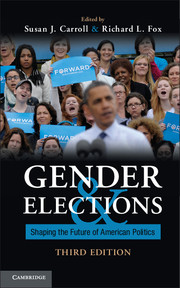Book contents
- Frontmatter
- Contents
- List of Figures, Text Boxes, and Photos
- List of Tables
- Contributors
- Acknowledgments
- Introduction
- 1 Presidential Elections
- 2 Cracking the “Highest, Hardest Glass Ceiling”
- 3 Voter Participation and Turnout
- 4 Voting Choices
- 5 Latinas and Electoral Politics
- 6 African-American Women and Electoral Politics
- 7 Congressional Elections
- 8 Political Parties and Women's Organizations
- 9 Advertising, Websites, and Media Coverage
- 10 Women's Election to Office in the Fifty States
- Index
- References
9 - Advertising, Websites, and Media Coverage
Gender and Communication along the Campaign Trail
Published online by Cambridge University Press: 05 June 2014
- Frontmatter
- Contents
- List of Figures, Text Boxes, and Photos
- List of Tables
- Contributors
- Acknowledgments
- Introduction
- 1 Presidential Elections
- 2 Cracking the “Highest, Hardest Glass Ceiling”
- 3 Voter Participation and Turnout
- 4 Voting Choices
- 5 Latinas and Electoral Politics
- 6 African-American Women and Electoral Politics
- 7 Congressional Elections
- 8 Political Parties and Women's Organizations
- 9 Advertising, Websites, and Media Coverage
- 10 Women's Election to Office in the Fifty States
- Index
- References
Summary
Twenty years after 1992's “Year of the Woman” campaign, in which record numbers of women ran for and were elected to political office, female political candidates recorded several significant political firsts in 2012. A new record was set in the number of women running for and elected to the U.S. Congress. New Hampshire became the first state to have an all-female delegation in the U.S. Congress as well as a woman governor. And the first openly gay woman was elected to the U.S. Senate.
Still, women running for state and federal political office continue to confront age-old challenges in their media coverage and, subsequently, how they frame their communication to voters through television advertising and websites. Three U.S. Senate candidates – incumbent Claire McCaskill (Democrat-Missouri), open-seat contender Deb Fischer (Republican-Nebraska), and challenger Elizabeth Warren (Democrat-Massachusetts) – demonstrate how successful women candidates used communication strategies to win their elections in 2012.
McCaskill, who became the first woman elected to the U.S. Senate from Missouri when she narrowly defeated the male incumbent in 2006, faced a serious reelection challenge in 2012 against U.S. Representative Todd Akin of Missouri’s second congressional district. The Tea Party-backed Akin led McCaskill in polls taken in March through late August, when his comment in a television interview that victims of “legitimate rape” rarely get pregnant because the female body “has ways to try to shut that whole thing down” derailed his campaign. Republicans – including presidential nominee Mitt Romney – were quick to denounce Akin for his remarks and demand that he leave the U.S. Senate race.
- Type
- Chapter
- Information
- Gender and ElectionsShaping the Future of American Politics, pp. 241 - 264Publisher: Cambridge University PressPrint publication year: 2013
References
- 1
- Cited by



